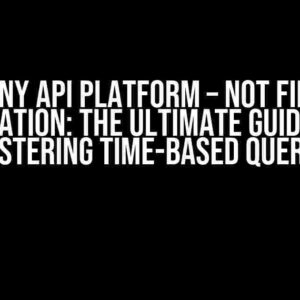If you’re a developer looking to deploy your React Typescript Three/fiber application on Netlify.com, you’ve come to the right place! In this article, we’ll take you through a step-by-step guide on how to do just that. So, buckle up and let’s get started!
Prerequisites
Before we dive into the deployment process, make sure you have the following:
Node.jsinstalled on your machine (version 14 or higher)yarnornpmpackage manager- A React Typescript Three/fiber project set up locally
- A Netlify account (sign up for a free account if you haven’t already)
Step 1: Prepare Your Project for Deployment
In this step, we’ll make sure our project is ready for deployment by creating a production build and configuring our environment variables.
Create a Production Build
Run the following command in your terminal to create a production build of your React application:
yarn buildornpm run build
This command will create a build folder in the root of your project, containing a minified and optimized version of your application.
Configure Environment Variables
Create a new file named .env in the root of your project and add the following variables:
REACT_APP_NETLIFY=true
REACT_APP_API_URL=https://your-api-url.com
Replace https://your-api-url.com with your actual API URL. These environment variables will be used in our Netlify deployment.
Step 2: Set Up Netlify
In this step, we’ll create a new Netlify site and configure our deployment settings.
Create a New Netlify Site
Log in to your Netlify account and click on the “New site” button. Fill in the required information, such as site name and repository, and click “Create site”.
Configure Deployment Settings
In your Netlify site settings, go to “Deploy” and click on “Edit settings”. Under “Build settings”, add the following:
Build command: yarn build
Publish directory: build
This tells Netlify to run the yarn build command to create a production build of our application and publish the resulting files in the build directory.
Step 3: Configure Three/fiber
In this step, we’ll configure our Three/fiber settings for deployment.
Install Three/fiber
Run the following command to install Three/fiber:
yarn add three-fiberornpm install three-fiber
Configure Three/fiber Settings
Create a new file named three.config.js in the root of your project and add the following:
module.exports = {
three: {
fiber: true,
},
};
This tells Three/fiber to use the fiber renderer, which is optimized for production deployment.
Step 4: Deploy to Netlify
In this final step, we’ll deploy our application to Netlify.
Go back to your Netlify site settings and click on “Deploy site”. Netlify will automatically build and deploy your application using the settings we configured earlier.
Verify Your Deployment
Once the deployment is complete, verify that your application is working as expected by checking the site URL provided by Netlify.
| Keyword | Description |
|---|---|
| Netlify | A platform for building, deploying, and managing modern web applications |
| React | A JavaScript library for building user interfaces |
| Typescript | A superset of JavaScript that adds optional static typing and other features |
| Three/fiber | A high-performance, low-level API for building 3D graphics in the browser |
Conclusion
That’s it! You’ve successfully deployed your React Typescript Three/fiber application on Netlify.com. By following these steps, you’ve ensured that your application is optimized for production deployment and takes advantage of the features offered by Netlify.
Remember to keep your project up-to-date with the latest versions of React, Typescript, and Three/fiber to ensure compatibility and performance.
If you have any questions or issues during the deployment process, feel free to ask in the comments below. Happy deploying!
[Note: This article is closed, meaning it’s no longer open for comments or updates.]
Frequently Asked Question
Get ready to unleash the power of React, TypeScript, and Three/Fiber on Netlify.com!
What is the best way to set up a React, TypeScript, and Three/Fiber project for deployment on Netlify.com?
To set up a React, TypeScript, and Three/Fiber project for deployment on Netlify.com, start by creating a new React project using `npx create-react-app my-app –template typescript`. Then, install Three/Fiber by running `npm install three-fiber`. Next, configure your `tsconfig.json` file to include the `three` module. Finally, set up your `netlify.toml` file to specify the build command and directory. Voilà!
How do I optimize my Three/Fiber scenes for deployment on Netlify.com?
To optimize your Three/Fiber scenes for deployment on Netlify.com, make sure to compress your 3D models and textures using tools like `draco` and `image-webpack-plugin`. Additionally, optimize your scene’s lighting, materials, and animations to reduce rendering complexity. You can also use caching and lazy loading to improve performance. Lastly, use Netlify’s built-in optimization features, such as code splitting and tree shaking, to further reduce bundle sizes.
What are the best practices for deploying a React, TypeScript, and Three/Fiber project on Netlify.com?
When deploying a React, TypeScript, and Three/Fiber project on Netlify.com, follow these best practices: use a `netlify.toml` file to specify the build command and directory, set up environment variables for your API keys and secrets, use a consistent naming convention for your files and components, and test your build locally before deploying. Additionally, make sure to monitor your site’s performance and optimize as needed.
How do I troubleshoot common issues with deploying a React, TypeScript, and Three/Fiber project on Netlify.com?
When troubleshooting common issues with deploying a React, TypeScript, and Three/Fiber project on Netlify.com, start by checking your build logs for errors. Then, verify that your `netlify.toml` file is correctly configured and that your environment variables are set up correctly. If you’re experiencing issues with Three/Fiber, try updating your dependencies or checking for compatibility issues. Lastly, reach out to Netlify’s support team or the React, TypeScript, and Three/Fiber communities for further assistance.
What are some advanced techniques for deploying a React, TypeScript, and Three/Fiber project on Netlify.com?
To take your React, TypeScript, and Three/Fiber project to the next level on Netlify.com, consider using advanced techniques like server-side rendering (SSR), code splitting, and lazy loading. You can also use Netlify’s built-in features, such as edge functions and asset optimization, to further improve performance. Additionally, explore using other technologies, like WebGL and WebVR, to create immersive experiences. The possibilities are endless!

![How to Deploy React Typescript Three/fiber on Netlify.com [closed] How to Deploy React Typescript Three/fiber on Netlify.com [closed]](https://rosann.hkhazo.biz.id/wp-content/uploads/sites/806/2024/07/how-to-deploy-react-typescript-three-fiber-on-netlify-com-closed-with-text.jpg)



